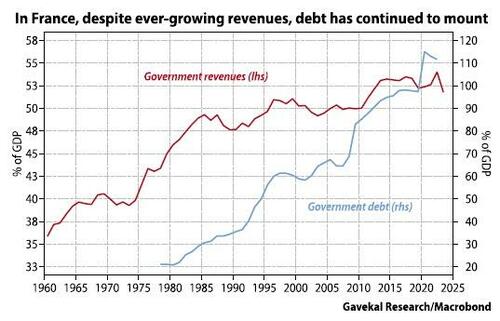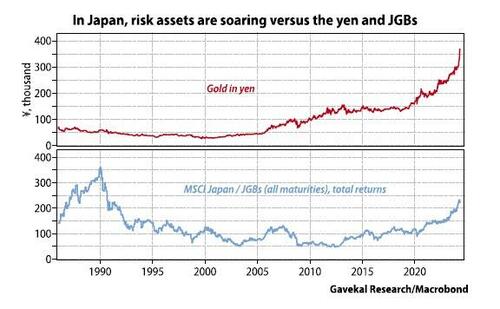
A Question To Challenge The Deflationary Mindset
Authored by Louis-Vincent Gave via Gavekal Research blog,
The rise in US treasury yields this year initially caused the usual casualties: the yen, won, euro, and British pound. From exchange rates, it seems that the US interest rate wrecking ball is now wreaking destruction among richly-valued technology stocks. Recent trading sessions have seen a vicious rotation in equity markets. It’s not every day that the Nasdaq falls by more than -2%, while the Russell 2000 gains 1%. In recent quarters, investors had become used to the opposite.
With rising US treasury yields causing pain in the currency markets and now among US growth stocks, investors will be wondering what the rise in yields will break next. Could rising yields break the back of the gold bull market? Or the unfolding emerging market boom? Or the nascent bull market in industrial metals and energy? What about economic growth in general?
The persistence of the idea that rising yields will eventually self-correct is testament to a fundamentally deflationary mindset. It is a mindset most investors share, since for the last 40 years, the world has been fundamentally deflationary. It reflects a belief that government bonds remain the ultimate risk free asset—even though long-dated US treasuries have lost half their value in the last four years.
This belief is based partly on governments’ ability to tax their populations in order to pay their past, present and future debts. But in a world where capital and individuals are ever more mobile, can we assume that a government’s ability to tax its citizens is limitless? Canada may now be putting this concept to the test. After it massively increased capital gains taxes, it seems likely its actual capital gains tax take will now be much lower than it would have been without the increase.
Canada is not alone. In France, over the last 50 years tax receipts have climbed from around a third of GDP to more than half. But even though it has taken a bigger slice of the economic cake in every cycle, the French government has not run a budget surplus since 1974. And with every downturn, budget deficits grow as a percentage of GDP. As a result, France’s debt has grown from around 20% of GDP to 112% today. France is now clearly on the downward sloping side of the Laffer curve.

Take the US commercial real estate meltdown as another example. Hardly a day goes by without news that an office building in New York, Los Angeles or San Francisco has sold for a fraction of the price it commanded five years ago. Interestingly, this seems to be happening mostly in “high-tax” states. Low-tax states such as Florida or Texas seem to have far fewer commercial real estate problems. Today, California, New York and other high-tax states may have reached the point where as taxes rise, citizens and businesses flee to lower-tax jurisdictions.
To cut a long story short, the recent blowout in US yields, the rollover in French tax receipts (and likely in Canadian tax receipts) in spite of higher tax rates, and the faceplant in US commercial real estate all raise questions about what happens when debt is already high relative to GDP (at 100% or more) and yet the growth of government spending still outpaces the growth of tax receipts year in, year out.

In such an environment, are government bonds still the default risk-free asset? Can investors trust that the government Leviathan will still be able to tap the economy for an ever-larger pound of flesh? Or, as we are seeing in the US today with the migration from high-tax to low-tax states, will people rebel and move? Or will they simply stop working as hard? Given the current direction of government policies, with the end of non-dom tax status in the UK and Canada’s increase in capital gains tax rates, it seems likely the coming years will provide an answer.
Three possible scenarios spring to mind.
1) Government spending continues to grow faster than tax receipts. Budget deficits continue to expand. And debt-to-GDP ratios continue to rise. In this scenario, it seems likely that more and more investors will look at the long term trajectory of public debt and conclude that the only way to square the circle is through ever-greater central bank debt monetization.
In such a world, government bonds will gradually lose their default risk-free asset status to risk assets like gold and equities.
2) Taxes increase, budget deficits come under control and debt-to-GDP ratios roll over.
In this scenario, government bonds reclaim their crown as the ultimate risk-free asset.
3) Governments shed assets (as Margaret Thatcher did in the UK in the 1980s) in order to get debt-to-GDP ratios under control.
The risk is that as governments shed assets, the prices of all assets fall.
Of these three scenarios, which seems the most likely?
Tyler Durden
Fri, 05/03/2024 – 10:55


















